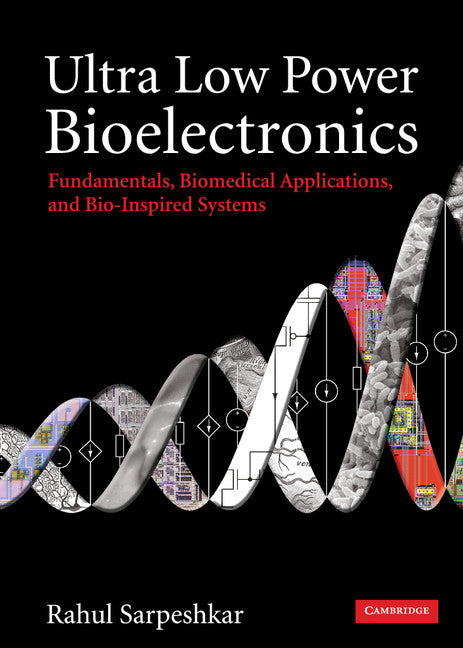Freshly Printed - allow 8 days lead
Couldn't load pickup availability
Ultra Low Power Bioelectronics
Fundamentals, Biomedical Applications, and Bio-Inspired Systems
Learn how to architect ultra low power robust electronics and how bio-inspired principles can revolutionize low power electronics design with this all-inclusive guide.
Rahul Sarpeshkar (Author)
9780521857277, Cambridge University Press
Hardback, published 22 February 2010
910 pages, 406 b/w illus. 15 tables 150 exercises
25.9 x 18.5 x 5.6 cm, 1.59 kg
'Sarpeshkar's focus on modeling cells as analog rather than digital circuits offers a new approach that will expand the frontiers of synthetic biology. Rahul has nicely laid a foundation that many of us in synthetic biology will be able to build on.' James Collins, Boston University
This book provides, for the first time, a broad and deep treatment of the fields of both ultra low power electronics and bioelectronics. It discusses fundamental principles and circuits for ultra low power electronic design and their applications in biomedical systems. It also discusses how ultra energy efficient cellular and neural systems in biology can inspire revolutionary low power architectures in mixed-signal and RF electronics. The book presents a unique, unifying view of ultra low power analog and digital electronics and emphasizes the use of the ultra energy efficient subthreshold regime of transistor operation in both. Chapters on batteries, energy harvesting, and the future of energy provide an understanding of fundamental relationships between energy use and energy generation at small scales and at large scales. A wealth of insights and examples from brain implants, cochlear implants, bio-molecular sensing, cardiac devices, and bio-inspired systems make the book useful and engaging for students and practicing engineers.
Part I. Foundations: Ten chapters lay a foundation in device physics, noise, and feedback systems including nano scales in a highly original fashion, emphasizing intuitive thinking. This foundation is important in designing and analyzing ultra-low-power systems in both electronics and biology
Part II. Low-Power Analog and Biomedical Circuits: Five chapters present building-block circuits that are useful for ultra-low-power biomedical electronics and analog electronic systems in general
Part III. Low-Power RF and Energy-Harvesting Circuits for Biomedical Systems: Three chapters provide an in-depth description of energy-efficient power and data radio-frequency (RF) links that are fundamental to biomedical systems
Part IV. Biomedical Electronic Systems: Two chapters provide an in-depth look at ultra-low-power implantable electronics and ultra-low-power noninvasive electronics for biomedical applications, respectively. Case studies for cochlear implants for the deaf, brain implants for the blind and paralyzed, wearable cardiac devices, and biomolecular sensing are provided
Part V. Principles for Ultra-Low-Power Analog and Digital Design: Two chapters discuss principles for ultra-low-power digital design and ultra-low-power analog and mixed-signal design, respectively. The chapters identify ten fundamental principles that are common in both biology and electronics, analog and digital design
Part VI. Bio-Inspired Systems: A chapter on neuromorphic electronics discusses electronics inspired by neurobiology followed by a chapter that discusses a novel form of electronics termed Cytomorphic Electronics, electronics inspired by cell biology. These chapters discuss applications of bio-inspired systems to engineering and medicine, deep connections between chemistry and electronics, and provide a unifying viewpoint of ultra-low-power design in biology and in electronics
Part VII. Energy Sources: A chapter on batteries and electrochemistry discusses how batteries work from a unique circuit viewpoint. The last chapter discusses energy harvesting in biomedical systems at portable scales (vibration and body heat) and at larger scales (low-power cars and solar cells). Principles of low-power design are shown to extend from small scales in electronics to larger scales and to non-electrical systems. This book reveals the deep connections between energy use and energy generation, vital for sustainable energy systems of the future.
Subject Areas: Radio technology [TJKR], Microwave technology [TJFN], Circuits & components [TJFC], Electronics engineering [TJF], Electronics & communications engineering [TJ]


